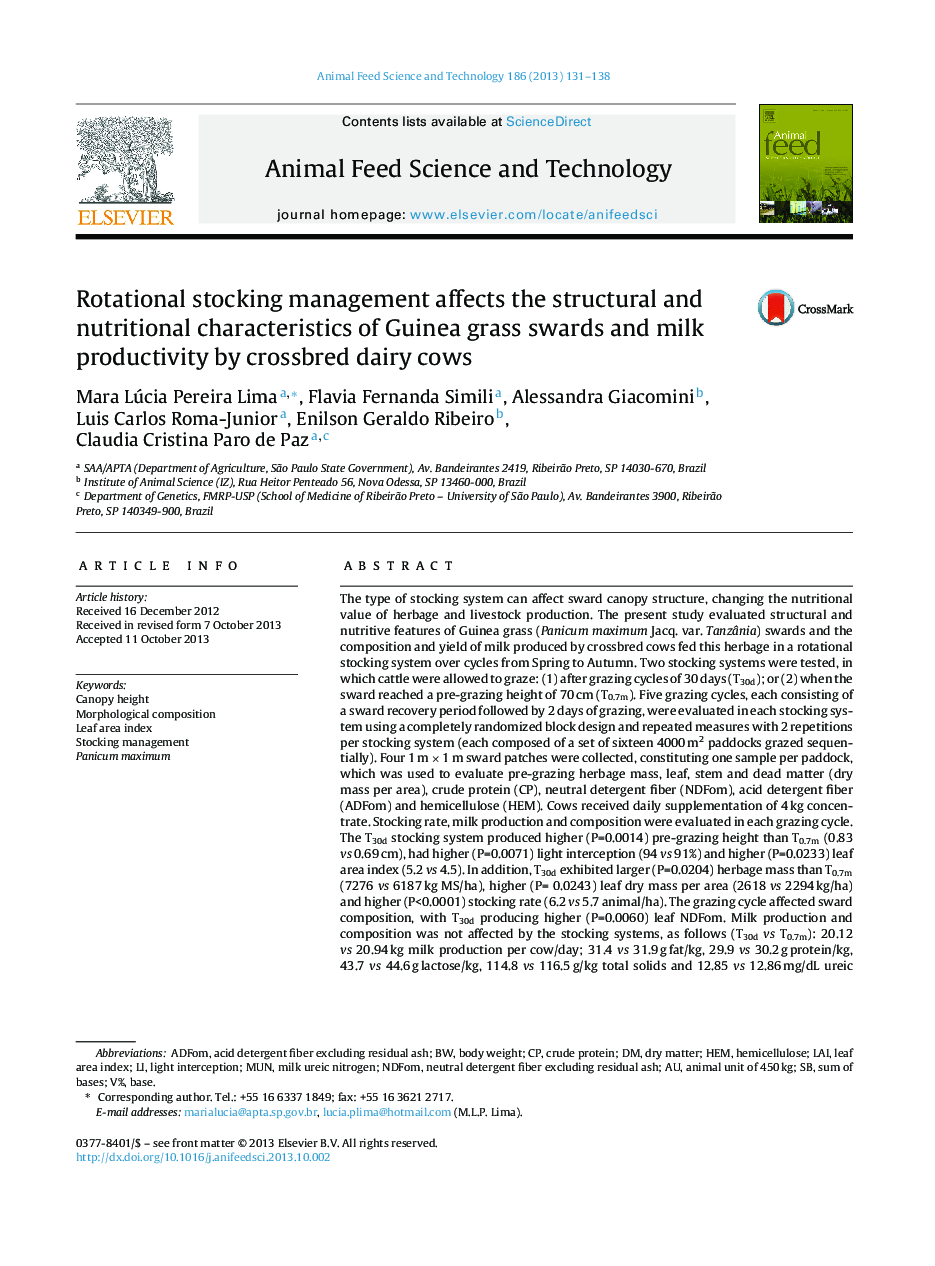| کد مقاله | کد نشریه | سال انتشار | مقاله انگلیسی | نسخه تمام متن |
|---|---|---|---|---|
| 8491812 | 1552399 | 2013 | 8 صفحه PDF | دانلود رایگان |
عنوان انگلیسی مقاله ISI
Rotational stocking management affects the structural and nutritional characteristics of Guinea grass swards and milk productivity by crossbred dairy cows
ترجمه فارسی عنوان
مدیریت انبارداری چرخشی بر ویژگی های ساختاری و تغذیهای گیاهان گویا و تولید شیر توسط گاوهای شیری متولد شده تاثیر می گذارد
دانلود مقاله + سفارش ترجمه
دانلود مقاله ISI انگلیسی
رایگان برای ایرانیان
موضوعات مرتبط
علوم زیستی و بیوفناوری
علوم کشاورزی و بیولوژیک
علوم دامی و جانورشناسی
چکیده انگلیسی
The type of stocking system can affect sward canopy structure, changing the nutritional value of herbage and livestock production. The present study evaluated structural and nutritive features of Guinea grass (Panicum maximum Jacq. var. Tanzânia) swards and the composition and yield of milk produced by crossbred cows fed this herbage in a rotational stocking system over cycles from Spring to Autumn. Two stocking systems were tested, in which cattle were allowed to graze: (1) after grazing cycles of 30 days (T30d); or (2) when the sward reached a pre-grazing height of 70 cm (T0.7m). Five grazing cycles, each consisting of a sward recovery period followed by 2 days of grazing, were evaluated in each stocking system using a completely randomized block design and repeated measures with 2 repetitions per stocking system (each composed of a set of sixteen 4000 m2 paddocks grazed sequentially). Four 1 m Ã 1 m sward patches were collected, constituting one sample per paddock, which was used to evaluate pre-grazing herbage mass, leaf, stem and dead matter (dry mass per area), crude protein (CP), neutral detergent fiber (NDFom), acid detergent fiber (ADFom) and hemicellulose (HEM). Cows received daily supplementation of 4 kg concentrate. Stocking rate, milk production and composition were evaluated in each grazing cycle. The T30d stocking system produced higher (P=0.0014) pre-grazing height than T0.7m (0.83 vs 0.69 cm), had higher (P=0.0071) light interception (94 vs 91%) and higher (P=0.0233) leaf area index (5.2 vs 4.5). In addition, T30d exhibited larger (P=0.0204) herbage mass than T0.7m (7276 vs 6187 kg MS/ha), higher (P= 0.0243) leaf dry mass per area (2618 vs 2294 kg/ha) and higher (P<0.0001) stocking rate (6.2 vs 5.7 animal/ha). The grazing cycle affected sward composition, with T30d producing higher (P=0.0060) leaf NDFom. Milk production and composition was not affected by the stocking systems, as follows (T30dvs T0.7m): 20.12 vs 20.94 kg milk production per cow/day; 31.4 vs 31.9 g fat/kg, 29.9 vs 30.2 g protein/kg, 43.7 vs 44.6 g lactose/kg, 114.8 vs 116.5 g/kg total solids and 12.85 vs 12.86 mg/dL ureic nitrogen. Stocking system therefore affects the nutritive value of sward. Stocking management allowing a 30-day grazing cycle for Guinea grass sward (T30d) produces higher forage mass, supporting a higher stocking rate and thereby increasing productivity in dairy farm.
ناشر
Database: Elsevier - ScienceDirect (ساینس دایرکت)
Journal: Animal Feed Science and Technology - Volume 186, Issues 3â4, 13 December 2013, Pages 131-138
Journal: Animal Feed Science and Technology - Volume 186, Issues 3â4, 13 December 2013, Pages 131-138
نویسندگان
Mara Lúcia Pereira Lima, Flavia Fernanda Simili, Alessandra Giacomini, Luis Carlos Roma-Junior, Enilson Geraldo Ribeiro, Claudia Cristina Paro de Paz,
